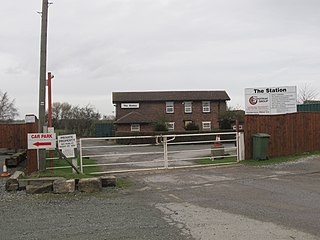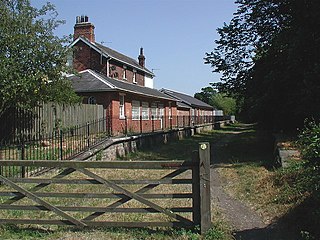
Hedon is a town and civil parish in Holderness in the East Riding of Yorkshire, England. It is situated approximately 5 miles (8 km) east of Hull city centre. It lies to the north of the A1033 road at the crossroads of the B1240 and B1362 roads. It is particularly noted for the parish church of St. Augustine, known as the 'King of Holderness', which is a Grade I listed building.

Stepney railway station is a disused railway station on the York and North Midland Railway's Victoria Dock Branch Line in Stepney, Kingston upon Hull, East Riding of Yorkshire, England. It was first opened on 8 May 1848 and closed in November 1854. It was reopened on 1 June 1864, before closing permanently on 19 October 1964. Located on the Victoria Dock Branch Line which looped around the old part of the city one could catch trains to the seaside resorts of Hornsea or Withernsea. Tickets were purchased in the small wooden building opposite the station building. Diesels took over from steam in January 1957. After the station closed, the lines through it were still used for goods trains until 1968. The few trains still travelling across Hull were diverted to the high level ex Hull and Barnsley Line which looped the city further north.

Ottringham is a village and civil parish in the East Riding of Yorkshire, England, in an area known as Holderness. It is situated approximately 12 miles (19 km) to the east of Hull city centre and 5 miles (8 km) south-west of Withernsea. It lies on the A1033 road from Hull to Withernsea.

Burstwick is a village and civil parish in the Holderness region of the East Riding of Yorkshire, England. It is situated about 8 miles (13 km) east of Hull city centre. It lies on the B1362 road.

Ryehill is a hamlet in the East Riding of Yorkshire, England, in an area known as Holderness. It is situated approximately 7 miles (11 km) east of Hull city centre and lies just south of the A1033 road,.

The Hull and Hornsea Railway was a branch line which connected the city of Kingston upon Hull with the seaside town of Hornsea in the East Riding of Yorkshire, England.
Sculcoates railway station was a railway station on the North Eastern Railway's Victoria Dock Branch Line in Hull, East Riding of Yorkshire, England. It was first opened by the York and North Midland Railway on 8 May 1848 and closed in November 1854. It was reopened in August 1865, before closing permanently on 9 June 1912.
Southcoates railway station was a railway station on the North Eastern Railway's Victoria Dock Branch Line in Hull, East Riding of Yorkshire, England. It was opened by the York and North Midland Railway on 8 May 1848. The station was closed in November 1854 and reopened on 1 June 1864 before final closure on 19 October 1964.

Withernsea railway station is a disused railway station that was the terminus of the North Eastern Railway's Hull and Holderness Railway in Withernsea, East Riding of Yorkshire, England. It was opened by the Hull and Holderness Railway on 27 June 1854.

Patrington railway station is a disused railway station on the North Eastern Railway's Hull and Holderness Railway in Patrington, East Riding of Yorkshire, England. It was opened by the Hull and Holderness Railway on 27 June 1854. The station was closed to passengers on 19 October 1964.

Ottringham railway station is a disused railway station on the North Eastern Railway's Hull and Holderness Railway to the north of Ottringham, East Riding of Yorkshire, England.

Keyingham railway station is a disused railway station on the North Eastern Railway's Hull and Holderness Railway to the north of Keyingham, East Riding of Yorkshire, England. It was opened by the Hull and Holderness Railway on 27 June 1854. The station was closed to passengers on 19 October 1964.

Rye Hill and Burstwick railway station is a disused railway station on the North Eastern Railway's Hull and Holderness Railway midway between Burstwick and Ryehill in the East Riding of Yorkshire, England. It was opened by the Hull and Holderness Railway on 27 June 1854. On 1 July 1881 it was renamed to Rye Hill and on 23 September 1929 changed name again this time to Rye Hill and Burstwick. The station was closed to passengers on 19 October 1964. It is now a private residence.

Hedon railway station is a disused railway station on the North Eastern Railway's Hull and Holderness Railway on the northern edge of Hedon in the East Riding of Yorkshire, England. It was opened by the Hull and Holderness Railway on 27 June 1854. The station was closed to passengers on 19 October 1964 and to freight on 3 June 1968.

Hedon Racecourse railway station is a disused railway station on the North Eastern Railway's Hull and Holderness Railway to the west of Hedon in the East Riding of Yorkshire, England. It was opened by the North Eastern Railway on 24 August 1888 to serve the newly opened Hedon Park Racecourse. The station was not timetabled and only operated on race days. The station was closed in 1909 when horse racing was terminated. The station was briefly re-opened as Hedon Halt between 14 August 1948 and 23 October 1948 to serve speedway meetings.

Victoria Dock railway station was the terminus of the York and North Midland Railway's Victoria Dock Branch Line in Kingston upon Hull, East Riding of Yorkshire, England.
Marfleet is an area of Kingston upon Hull, East Riding of Yorkshire, England, in the east of the city, near King George Dock.
The York, Hull and East and West Yorkshire Junction Railway was a proposed railway line, promoted in the mid 1840s, intended to connect York to the East Riding of Yorkshire, England.
The Victoria Dock branch line was a branch line within the city of Kingston upon Hull that connected the Hull and Hornsea Railway to the east and the York and North Midland Railway and Hull and Selby Railway to the west, terminating at Victoria Dock Station.

Hedon Haven is a waterway that connected the Humber Estuary with the port of Hedon, in Holderness, East Riding of Yorkshire, England. The waterway allowed ships to unload at the port in Hedon, which was also known as Hedon Haven and had, at its peak, three canalised arms that stretched into the town. The port at Hedon was the main port for south Holderness between the 12th and 13th centuries, and was the busiest port in Holderness before the docks at Hull were built.















